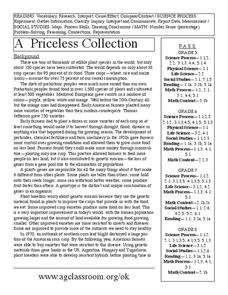Curated OER
Cardboard Radial Weaving
Students explore cultural history by participating in an arts and crafts activity. In this weaving lesson, students identify the many cultures that used weaving methods and local plant life to create baskets and other useful tools....
Curated OER
Populations – The Survival of the Fittest (Part 1)
Students explain in their own words why organisms live together. In this biology lesson, students model what happens to organisms if their environment changes. They explain the importance of evolution.
Curated OER
Plant Science: Introduction to Photosynthesis
Students explore the process of photosynthesis in plants. They discuss the purpose of photosynthesis and its components. Students discuss the importance of photosynthesis for plants and they examine the parts of the plant that play an...
Curated OER
Sorting
Students experience sorting. In this organization lesson, students play a computer sorting game called "Flood Game" on the "Between the Lions" website. Students visit a library and observe and discuss book organization. Students work in...
Curated OER
Food Web Mobile
Students explain the main concepts of food webs and food chains. They
describe the role of animals, plants, and other organisms in cycling energy and matter through a food web by creating mobiles. Lesson contains adaptations for all levels.
Curated OER
Eutrophication Lab
Students examine the effects of detergents and fertilizers on aquatic life and describe algae. Students define the term eutrophication as the process by which a body of water, such as a pond, lake, stream, or river, has a sudden increase...
Curated OER
Dirty Decomposers
Students explore the ecosystem by conducting a ziploc bag experiment. In this recycling lesson, students identify decomposer organisms in our environment and how they speed up the recycling process. Students utilize a ziploc plastic bag,...
Curated OER
Food Chains and Webs--- "What's for dinner?"
Students study food chains and how the organisms are linked. In this investigative activity students answer food chain questions, and fill out several worksheets.
Curated OER
Bugs in the Woods
Second graders identify insects and plants in the forest ecosystem in a structured field trip with stations and activity booklets. In this bugs lesson, 2nd graders explore the ecosystem of the forest, complete the booklet and play...
Curated OER
Ecosystems
Students study ecosystems and the biodiversity within. In this ecosystems lesson students complete a lab activity and assess the biodiversity in their own community.
Curated OER
Plant Cycles
Students identify plants parts and their functions. In this plant cycle lesson, students examine parts of plants and how the parts help them survive in its environment. Students use graphic organizers, the internet, books and...
Curated OER
From One Seed Grow Many Seeds
First graders practice identifying plants by singing a song. In this plant life activity, 1st graders sing the song "Parts of a Plant" which is based on the anatomy of sunflowers. Students discover agriculture techniques...
Curated OER
Organisms and Their Environment
Students observe elements of a local ecosystem and gain an understanding of what elements make up an ecosystem. In this ecosystem lesson students create a class food web that shows the interactions among the elements of the...
Curated OER
How Do Plant Life Cycles Vary?
In this plant life cycle worksheet, students will complete this graphic organizer by writing in the 3 steps in a plant life cycle.
Curated OER
Plants-Missing Letters Spelling Activity
In this plant spelling worksheet, learners are given definitions of words related to plants and fill in the missing letters to finish the matching word. A reference web site is given for additional activities.
Curated OER
A Priceless Collection
Students read and discuss the background of plants, seeds, and gene banks and grow seeds on their own. In this seeds lesson plan, students also use maps to identify seed banks and research plant farmers.
Curated OER
How Do Plants and Animals Get Energy?
In this food chain learning exercise, students will determine where plants and animals get their energy by filling in the blank of 4 statements.
Alabama Learning Exchange
Nature's Life Cycle
Become a member of the Pollution Patrol and stand up to litter! After discussing the life cycle of seeds and discussing how plants figure into the food chain, young conservationists engage in several activities involving podcasts,...
Curated OER
What Makes a Plant a Plant?
For a plant unit in your biology curriculum, here is a slide show that bestows the basics of plant structure, reproduction, and classification. The information is general. The main point of the lesson is to highlight what characterizes...
Curated OER
Light and Starch Production in Photosynthesis
Students are given the unique opportunity to see the contrast between parts of a leaf that have photosynthesized and parts of the leaf that have not. This visual image helps students see the results of this biological process. At the...
Curated OER
Amounts of Dissolved Oxygen in Various Bodies of Water
Students test water to determine the dissolved oxygen content while displaying the proper use of testing instruments while visiting water testing sites. They determine if the amount of dissolved oxygen is appropriate for the tested...
Scholastic
Study Jams! The Kingdoms of Life
Life science learners discuss the characteristics of five kingdoms of life: animals, plants, fungi, protists, and bacteria in this video. Viewers find out from the dialogue that scientists group organisms according to similarities. This...
Curated OER
North Dakota Plants with Lewis and Clark
Tenth graders identify native plants of North Dakota. They compare the plants found on native prairie with the plants described in the Lewis and Clark journals. They present the information they have collected in an electronic format...
Curated OER
Environmental Conditions: Friend or Foe
Students research and answer questions on how organisms are classified and how their needs are met through their environment. They work in small groups and create a poster, chart, rap, PowerPoint, or brochure demonstrating how organisms...






















